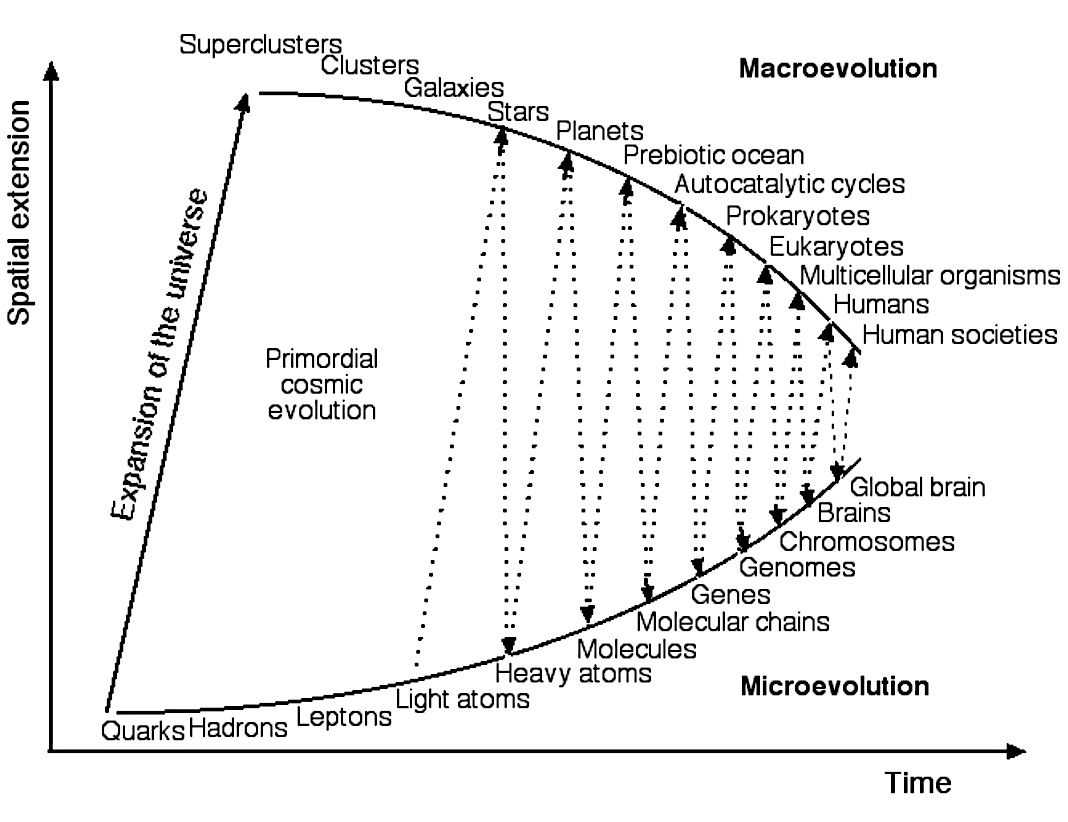
Description of the image: The self-organization of the material universe according to Erich Jantsch (1929-1980). In his book "The Self-Organizing Universe," Erich Jantsch showed that the entire universe self-organizes, from the Big Bang to human societies. This diagram illustrates a "macroevolution" during which large structures condense and alternate with a "microevolution" during which new elementary components form. Light atoms form stars which form heavy atoms, which form planets, which form molecules, and so on. In this process, energy that is conserved dissipates increasingly quickly. It tends to irreversibly transform into heat: this is the arrow of time.
In the 16th century, Earth became a planet like any other. In the 19th century, the Sun is one star among billions. In the 20th century, our Milky Way is one galaxy among billions of galaxies, but our perception of the universe might be incomplete.
In the 21st century, it is possible that our world will become one world among billions of others.
If we observe the world in a familiar material reality, it is because we are made of matter. Any theory that includes our existence must necessarily be consistent with our own construction.
Our emergence is the result of a process obeying the laws of thermodynamics. This process has engendered a self-organization oscillating between macroevolution and microevolution (see diagram).
In the evolution of our Universe, structures appear spontaneously under a constant flow of dissipating energy. Light atoms generate stars which generate heavy atoms which generate planets which generate molecules, which generate prebiotic oceans. And this continues with molecular chains, autocatalytic cycles, genes, prokaryotes, genomes, eukaryotes, chromosomes, multicellular organisms, brains, humans, a global brain, human societies, and tomorrow, parallel worlds.
This process is accelerating, and we observe an irreversible self-acceleration in the dissipation of the original energy.
But the three-dimensional material world may only be an illusion!
The material objects around us are just one possible representation of reality.
At the very heart of matter, the quantum world shows us intense energy where matter occupies an insignificant volume. There is nothing at all, only empty space in which matter appears and disappears constantly, in multiple places and in multiple states simultaneously. Furthermore, there is no distinction between past, present, and future. This opens the doors to a multitude of probable worlds, to an infinite number of parallel worlds that could give rise to a metaverse.
Quantum matter resembles a packet of information that, once interpreted by our brains, will form the objects of the real world. Among all possible worlds, our consciousness selects the most probable one, the one that has been chosen by our senses to experience the reality.
But will the future reality not be virtual!
N.B.:
The Russian physicist and chemist Ilya Prigogine (1917-2003), Nobel Prize in Chemistry in 1977, showed that self-organization is a characteristic of dissipative structures, i.e., structures that appear spontaneously under a constant flow of energy. Any structure that exchanges energy or matter with its environment is a dissipative structure, from galaxies to human societies.

Description of the image: The metaverse is a dissipative structure. An infinity of coded information will be required to create virtual worlds appearing and disappearing within the network structure of the internet. The parallel worlds thus created, endowed with artificial intelligence, will produce their own information. Thus, the dissipative system (exchange of energy, creation of entropy), and the spontaneous appearance of a spatial symmetry breaking (anisotropy) will become chaotic. A new stage will be necessary in the macroevolution.
The concept of the metaverse was described in 1992 in Neal Town Stephenson's (1959-) novel "Snow Crash." This fictional account depicts an imaginary society organized in such a way that it is impossible to escape from it.
The metaverse could well be the continuation of the macroevolution that began 13.77 billion years ago. The metaverse or meta-universe is a set of parallel worlds into which we will slowly but irresistibly enter.
These virtual worlds may be close to the real world or completely disconnected from it.
For some citizens, these parallel worlds will be terrifying. They will no longer be able to exercise their free will and will be tossed about by an invading flow of energy. Others may acquire a gift of ubiquity. Virtual reality headsets, augmented reality glasses, immersive experiences, their avatars will become part of their environment.
Avatars (immaterial beings) will be able to follow all events in the metaverse while we (material beings) will remain in the dull and boring physical world.
It is very easy to deceive our brain by presenting it with packets of information created by computer software. These imagined virtual worlds can host a community of users present in the form of avatars moving and interacting in three dimensions. These worlds can adhere to physical laws (gravity, time, space, energy, etc.) but can also create new ones.
These worlds will be dissipative structures where generated information will continue to increase exponentially for some time. Even though new technologies will reduce the energy consumption of data centers, the phenomenal increase in information mass will make the system chaotic. Another stage in macroevolution will occur when these data centers dissipate more energy than the planet produces. In 2020, data center electricity consumption (500 TWh) represented 2% of global electricity consumption.
N.B.:
"Snow crash" in computing refers to a complete system crash that fragments the part of the computer responsible for displaying pixels on the screen, resulting in an apocalypse of Information.